The Economic Impact of Unions
Many people assume that unionized employees receive better earnings compared to their non-unionized counterparts. This perception is based on the fact that a union can initiate an industrial strike to compel a firm to pay its members better wages. As a matter of fact, the data prepared by the Bureau of Labour Statistics in 2008 showed that unionized workers earned approximately $23.8/hour compared to their non-unionized counterparts who earned $19.95/hour.
However, the wage differential between the unionized and non-unionized workers is not clear. For example, consider a union member employed by a firm in an extremely competitive industry. If other employees in rival firms are non-unionized, this firm will incur substantial losses if it offers a superior pay to its unionized workers compared to the earnings of the non-unionized employees in rival firms. Even though the union can inflict strike costs on the firm, it would nonetheless have to deal with the predicament of “no firm” or “no wage advantage” if it proceeds with the industrial strike.
Another major dilemma is how to measure pure union-nonunion differential. This dilemma surfaces since the unionization can increase or decrease the wage rate in nonunion labour markets thereby generating a predisposition with respect to the estimation of the union wage advantage. At this point, it is important to note that the pure union wage advantage refers to the percentage difference by which the union wage surpasses the nonunion wage. The pure union wage advantage (A) is expressed in the following equation below:

Where Wu= union wage and Wn=nonunion wage. In reality, the union wage advantage (A) is computed under controlled environment whereby the union wage and the nonunion wage are evaluated against other potential factors that influence the wage rate (see fig. 1).
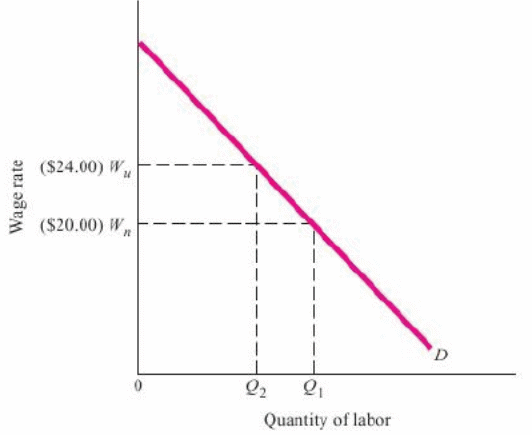
There are various effects that explain the manner in which the union wage rate can sway the nonunion wage rate. For example, the spillover effect is defined as the decrease in nonunion wages when union employees offer their labour services in the nonunion labour market. The superior earnings attained in the unionized segment of the labour market will be followed by job loss. In addition, the displaced unionized employees will relocate to the non-union segment of the labour market and condense non-union wage rate (see fig. 2). The threat effect, happens when a nonunion employer offers a higher non-union wages to counter the union wage rate.
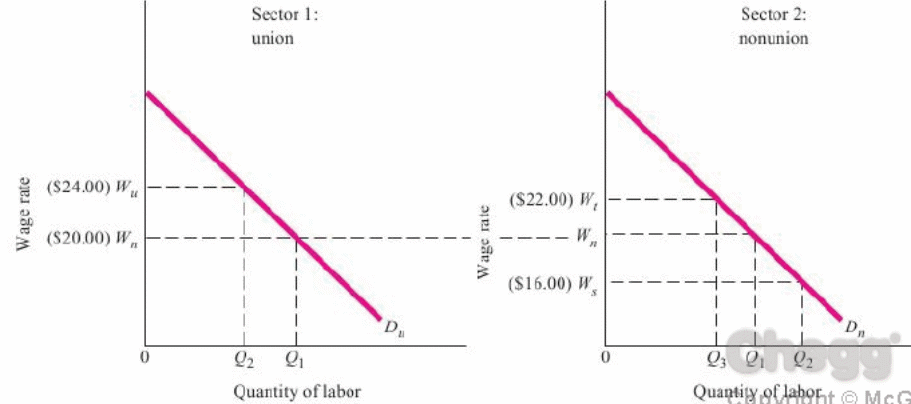
The rationale here is that some firms that hire non-unionized worker are more intimidated by the unionization since their employees command superior wages. As a result, a substantial wage differential between the unionized and the non-unionized employees will motivate the latter to demand a wage increase. Therefore, firms that employ non-unionized workers will offer higher wages in order to counter this threat.
For instance, if we begin at the equilibrium wage (Wn) in both the unionized and the non-unionized sectors (fig. 2), the increase in the wage rate (from $20 to $24) brought about by the unionization of sector 1 will likely raise the wage rate in the nonunion sector (sector 2) from $20 (Wn) to about $22 (Wt).
There are other effects that demonstrate the manner in which the union wage may impact the non-union wage. A case in point is the product market effect which is defined as a rise in the non-union wage which occurs when consumers spent more on low-cost products produced by non-unionized employees. In addition, there is the superior worker effect whereby employees in the labour market flock to the unionized firms that offer superior wages. Given the high prevalence of job seekers in the market, the unionized firms will adopt precautionary measures and hire the most skilled workers. This implies that unionized firms that offer superior wages will prefer to hire skilled employees in the long run.
It deserves merit to explore the manner in which the unionization influences the fringe benefits. As a matter of fact, it has been established that unionized employees have better fringe benefits compared to their non-unionized counterparts. For example, several studies have shown that unionized workers are 31% more likely to get health insurance and pension coverage compared to 25% for the non-unionized workers. In a nutshell, there is a general concurrence that unionized employees enjoy not only substantial fringe benefits but also a wage advantage than their non-unionized counterparts.
There are two divergent views regarding the manner in which unionization influences the efficiency and productivity in the economy. The negative view holds that unionization may negatively influence productivity in three elementary ways. First, unionization introduces restrictive work regulations that reduce the efficiency within the unionized firms. Second, a unionized firm may experience loss of output in the advent of a union strike. Third, the union wage advantage usually alters the wage structure in the labour market. As a result, labour is poorly misappropriated between the unionized and the non-unionized firms (see fig. 3).
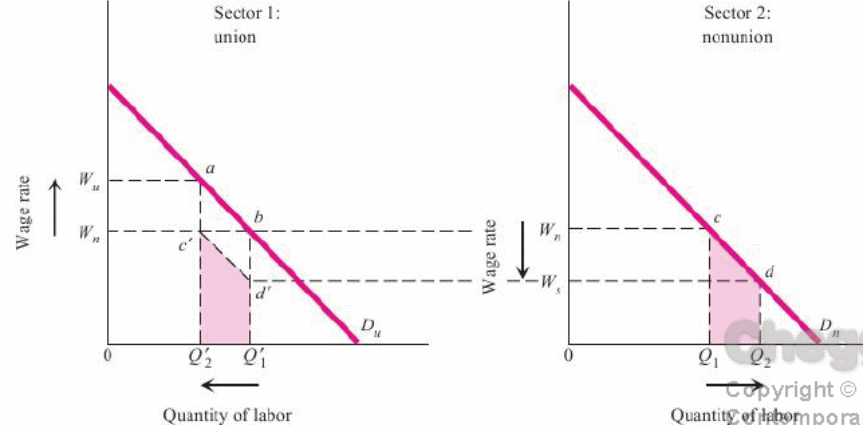
The positive view holds that unionization has a positive impact on the efficiency and productivity of a firm. For instance, some economists posit that a higher union wage can speed up the replacement of capital for labour. In addition, it motivates the unionized firms to search for technologies that enhance productivity. For example, when the union wage advantage increases the cost of production, the firm may adopt capital-intensive production techniques in order to reduce reliance on labour. In addition, some experts concur that unionization enhances the productivity of a firm. For example, employees can use their unions to air and resolve their complaints, promote managerial efficiency and minimize employee turnover.
What is more, some researchers concur that unionization has a negative impact on the profitability of a firm. For example, Freeman and Medoff have shown that unionization reduces the profitability of a firm by 36%. In addition, Voos and Mishell analysed data from about 135 manufacturing firms and showed that unionization reduced a firm’s profit margin by about 22%. What is more, some experts argue that unionization has both positive and negative impacts on the distribution of earnings. For instance, it augments asymmetrical distribution of earnings via the spill-over effect. In addition, it has been proven that unionization boosts the demand for skilled workers within the unionized firms.
However, some people assert that unionization promotes equality in the distribution of wages. For instance, some firms are likely to offer dissimilar wages to employees in the same job in the absence of unions. It is worth mentioning that the main objectives of the unions are to pursue uniform wages among firms and reduce the wage differential between the white-collar and blue-collar workers. In a nutshell, unionization elevates wage inequality in two basic ways.
First, it raises wages of the unionized employees but decreases the earnings of non-unionized employees. Second, an increase in the union wage encourages firms to hire highly skilled employees. What is more, unionization enhances wage equality since unions pursue homogeneous earnings for a particular job within firms. Furthermore, unionization reduces the wage gap among the white-collar and the blue-collar employees.
Government and the Labour Market
In most labour markets, the government is the main employer of many types of workers such as firefighters, agency managers, university lecturers, park rangers, air traffic controllers, law enforcement personnel and postal employees. The growth and magnitude of government employment in the United States are depicted in figure 4.1 and figure 4.2. According to figure 4.1, the number of people employed by the government increased dramatically at both the local and the state levels. Furthermore, figure 4.2 shows that the number of civilians employed by the federal government reduced slightly between 1950 and 2005 while the local and state employment rose dramatically during the same period.
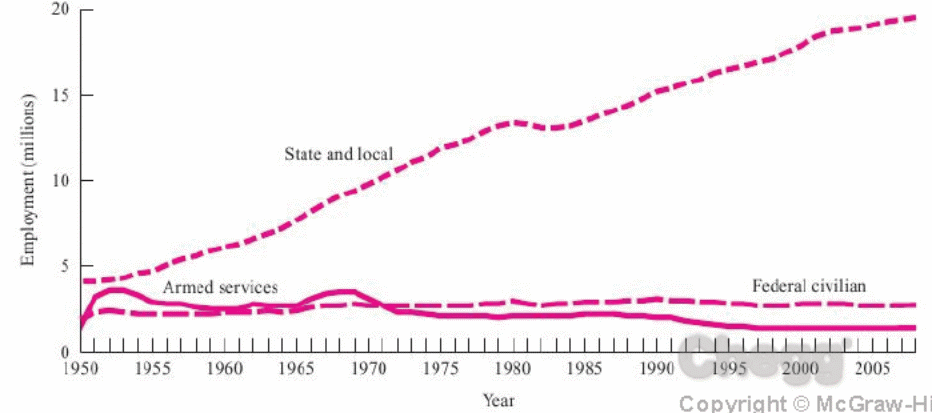
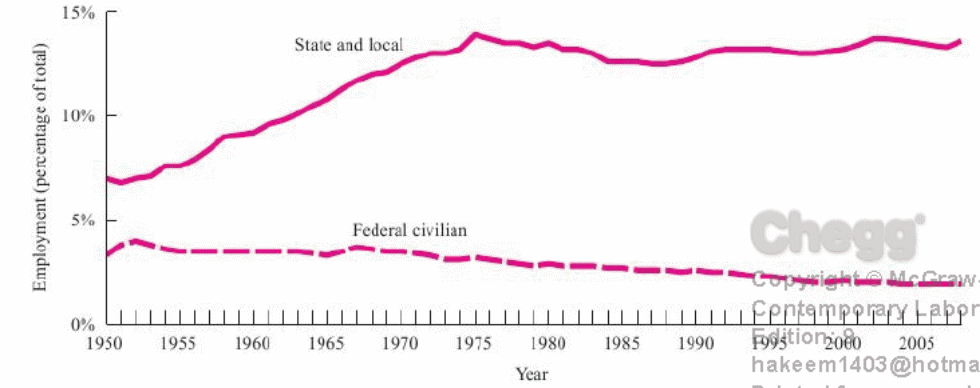
It is worth mentioning that the United States’ military staff has dramatically reduced from 3 million to 1.4 million between 1970 and 2008. In addition, figure 5 shows the demand and supply of labour (as perceived by the military). There are two crucial assumptions at this point. First, we assume that the country is not at war. Second, we assume that the labour market that provides recruits to be enlisted in the military is perfectly competitive.
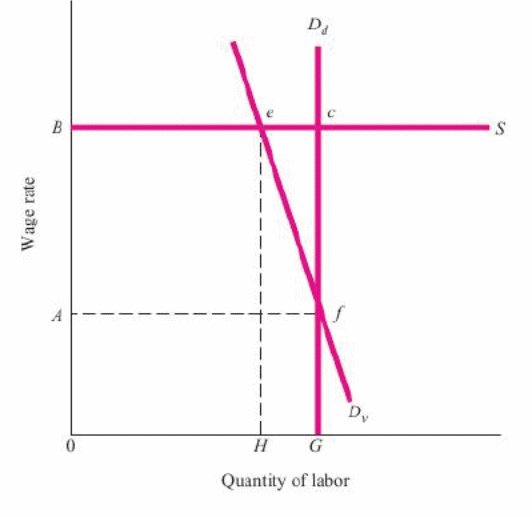
The competitive supply curve (as perceived by the military) is denoted by the curve S. The demand curve Dd (which is perfectly inelastic) is based on the postulation that the Congress approves the military to enlist 0G personnel and offer them a wage rate equal to 0A. Furthermore, the demand curve Dv depicts the economic impacts of a market-based army or a voluntary-based army (see fig. 5). For instance, the intersection of S and Dv results in the equilibrium quantity of labour (0H) and equilibrium military wage (0B). Thus, the military’s aggregate wage bill will be 0BeH. This wage bill is substantially larger than the total wage bill (0AfG) under the draft.
If the demand for recruits by the military is relatively inelastic, the taxpayers will incur additional costs to enable the voluntary army enlist additional military personnel. In summary, the efforts by the government to draft recruits in the military demonstrate the manner in which the government can sway certain labour markets.
It is also important to discuss the manner in which the provision of public goods and services influence the demand for labour. For example, a public good that complements the production of a particular private good will augment the derived demand for employees engaged in the production of the private good. On the other hand, when a public good is used as a substitute in the consumption or production of a particular private good, then it will decrease the derived demand for employees engaged in the production of the private good.
What is more, it is important to note that the provision of public goods may decrease the supply of labour in the economy. In other words, a public good can dramatically reduce labour supply if it is used as a substitute in the production of private goods. For instance, food stamps offered by the federal government may decrease the inducement to earn income to purchase food.
The impact of income tax on employment deserves consideration. The elasticity of labour supply is a major factor that determines the manner in which the personal income tax affects employment and wages. Figure 6a shows that the labour supply curve is perfectly inelastic. Thus, a change in the wage rate does not alter the employees’ participation in the labour market. Conversely, the labour supply curve in figure 6b is relatively elastic.

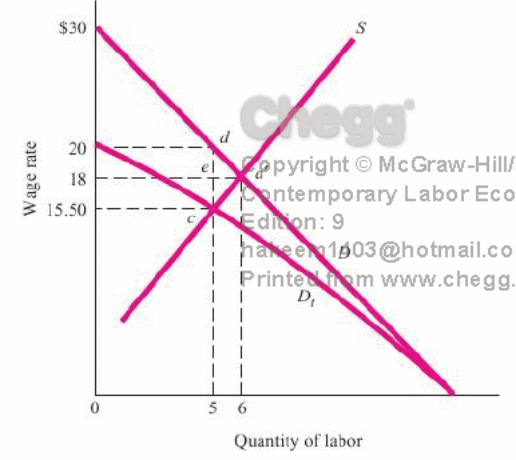
In other words, when the wage rate increases, workers will increase their participation in the labour market and vice versa. What is more, it is hypothetically difficult to ascertain how the income tax can influence the optimal labour supply of an employee. This is because the tax produces income and substitution effects that function in conflicting ways in terms of the quantity of labour supplied.
Legislation and Regulation
Legislations and regulations that oversee labour relations are integral institutional elements that influence resource distribution, employment and wage rates. For example, the labour market is affected by the labour regulations in two major ways. First, labour laws control the unionization process. In other words, a union can employ labour laws to bargain for better wages on the behalf of its members. Second, labour regulations specify the rules that must be followed during the collective bargaining process. For instance, the main purpose of the Wagner Act was to foster unionization within the labour market.
To be precise, the Wagner Act prohibited employers from interfering in the affairs of the unions. As noted earlier, labour laws promote the unions’ collective bargaining power by enabling them to secure better remuneration packages for their members.
For example, the Norris-LaGuardia Act [1932] prohibited employers from using injunctions to regulate union activities such as strikes. As a result, this law augmented the collective bargaining power of the unions. What is more, the Landrum Griffin Act [1959] prohibited hot-cargo contracts. The Landrum Griffin Act also boosted the bargaining power of the unions in many labour disputes. Furthermore, many employers benefited from this law. For instance, the law allowed firms to undertake production and marketing activities (using strikebreakers) in order to sustain their profits during industrial strikes.
The labour market is also influenced by the government legislation through the Fair Labour Standards Act [1938]. This Act stipulated that employees in the labour market should be paid a minimum wage of $ 0.25/hour. Nonetheless, this Act has been amended several times by the Congress in order to reflect the prevailing economic conditions. For instance, the US Congress raised the minimum wage to $4.25/hour in 1991.
The minimum wage was later increased to $5.15/hour in 1996 in order to account for the inflation which transpired during this period. However, the minimum wage is currently a contentious subject. Those in favour of the minimum wage assert that it ensures that employees can earn an adequate income that enable them to afford basic needs such as food, shelter and medical care. Conversely, those against the minimum wage claim that it amplifies unemployment especially among the minorities.
The impact of the minimum wage on the labour market can be explored using the labour demand and supply model. For example, figure 7 shows how the minimum wage (Wm) affects the labour market when the equilibrium employment level is at Q0 and the equilibrium wage rate is at W0. If Wm≤ W0, this means that the minimum wage law is extraneous. In addition, the real employment level and the wage level will stay at Q0 and W0 respectively.
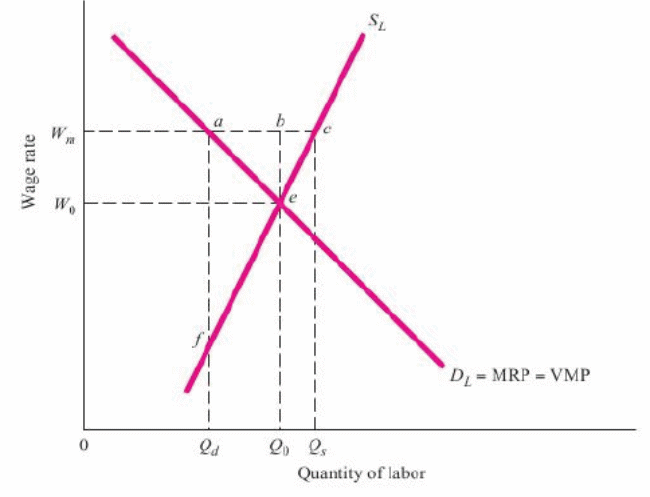
Figure 7 depicts three scenarios regarding the impact of the minimum wage on the employment and unemployment levels. First, a firm will recruit only Qd employees if the minimum wage is at Wm. Second, the manner in which the labour suppliers and firms act will be determined by Wm. For example, if the unemployment rate rises by ac, the employment rate will reduce by ba. Third, Wm brings about allocative inefficiency. Nonetheless, the impact of the minimum wage may be rendered irrelevant if some employers do not comply with the minimum wage law.
Workplace safety is also an important issue that merits consideration in the labour market. It is against this backdrop that the Occupational Safety and Health Act established standards for workplace safety that must be adopted by employers. Finally, the government employs rent provisions to influence employment and wage rates in some labour markets.
Labour Market Discrimination
Statistical evidence suggests the prevalence of discrimination in the labour market. Discrimination in the labour market happens when a black worker or a female employee (with identical education qualifications and work skills as those of white workers or male employees) are unfairly treated with regard to wage levels, job promotion and hiring. For instance, there is a considerable gap in terms of human capital accumulation, unemployment levels and earnings among the whites and the African-American in the US labour market. Figure 8 shows the ratio of the wage rate between male and female from 1973 to 2009.
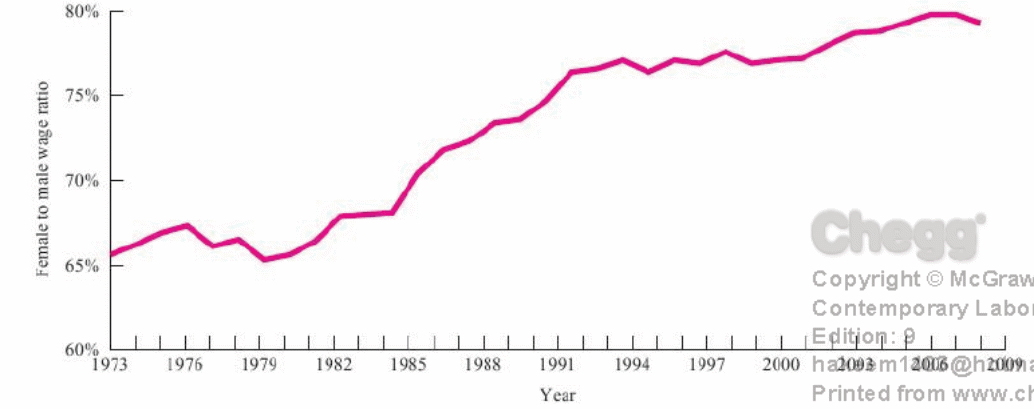
The data presented in figure 8 reveals that the wage rate for women employees was approximately 64% of those of men between 1973 and 1978. However, the wage rate has dramatically increased since then to approximately 80%. Several theories have been proposed to explain the declining gender difference in earnings. First, some economists suggest that many female employees have improved their work-related skill. Second, anti-discrimination laws have dramatically reduced the gender discrimination in the labour market. Third, the waning influence of the unions may have had a more negative effect on male earnings compared to the female earnings.
What is more, figure 9 reveals information pertaining to the unemployment levels in terms of gender and race in the US. The data presented suggests that white males enjoy more employment opportunities compared to their female counterparts. However, this disparity has dramatically reduced since the 1970s. On the other hand, the unemployment levels among African-American have almost doubled those of the whites.
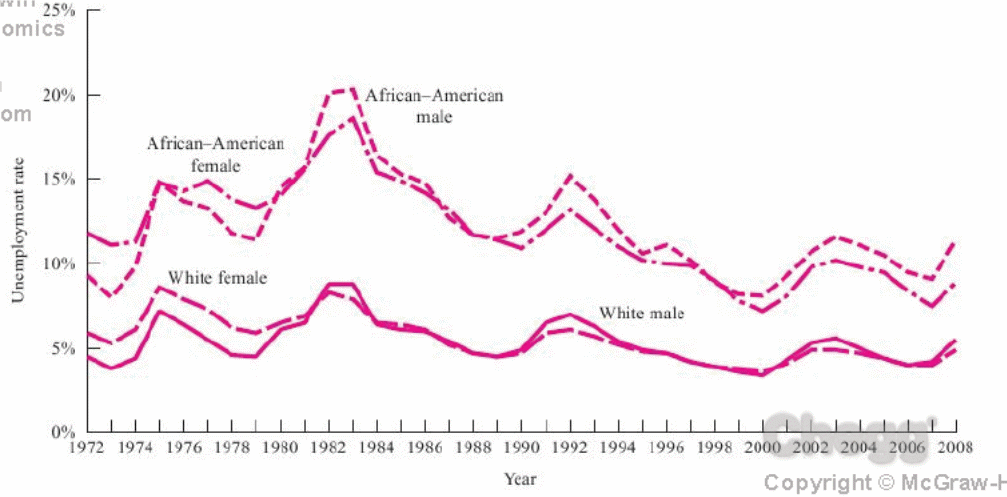
What is more, the unemployment levels of males and females (in each race) are almost analogous. It is also important to note that approximately 10.8% of the labour force in the US is made up of the African-Americans and majority of them are found in low-income jobs such as nursing assistants, cleaners and security guards.
The discrimination model suggested by Becker explains the prevalence of discrimination in the labour market. Becker suggests that some white employers have a preference for discrimination which can be calculated using the discrimination coefficient (d). For example, a biased white employer may consider employing an African-American if the wage rate of the whites is higher than that of the African-Americans. What is more, according to the Becker’s model, African-Americans are likely to gain if the discrimination coefficient (d) reduces. For example, it will create more employment opportunities for the African-Americans.
It will also increase the ratio of earnings between the African-American and the whites. In addition, the theory of statistical discrimination reveals that firms with a profit – making objective will hire employees on the basis of their superficial attributes. This decision is based on the fact that employers incur huge costs in order to acquire comprehensive information regarding the efficiency of the prospective job candidates.
The crowding model employs demand and supply analysis to show that occupational crowding increases the wage rate for white males and decreases the wage rate for African-American women. In addition, there are some non-discriminatory aspects which can justify the existence of wage differentials amongst the whites and the African-Americans. However, racial and gender discrimination are the major reasons for the wage differential among the whites and the African-Americans in the United States. Nevertheless, several laws have been enacted to address discrimination in the labour market.
Examples include the Civil Rights Act [1964] and the Equal Pay Act [1963]. It seems that these legislations have played a positive role in reducing the gender and racial discrimination in the labour market. This is evidenced by the fact that the wage rates and employment opportunities for many African-Americans have improved substantially in the labour market.